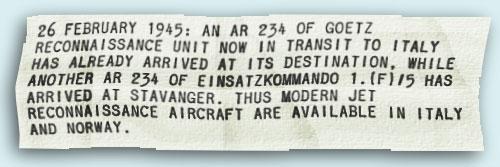 |
||
|
Obtaining reconnaissance cover of the North Sea and the English coast as far north as the River Humber seems to have been of importance to German commanders once Kdo. Sperling began operating from German soil with recurring orders to cover the port of Hull, apparently to watch for the assembly of any new Allied amphibious force. In addition, Ju 188s of 3.(F)/122 flew most days from Quakenbrück or Grove on security reconnaissance of sea areas Fisher and German Bight. Both the General der Aufklärungsflieger’s War Diary and deciphered signals make clear however that Ar 234 reconnaissance from Norway was to support the conduct of the late-war U-boat campaign in the North Sea. Surviving Allied and German information provides a reasonably clear picture of the build-up to jet reconnaissance operations under the auspices of the Luftwaffe’s Commanding Generals for Denmark and Norway. There is only a sporadic picture of the flights themselves, often derived from Luftwaffe communications with the branches of the Kriegsmarine on whose behalf these missions were being flown.
On the morning of 29 January 1945 there was traffic between Stavanger and a “probably non-operational” aircraft which was based at Aalborg and belonged to Versuchsverband OKL. It was thought that this was the machine which attempted a reconnaissance of the British Home Fleet’s Scapa Flow anchorage around noon the same day. CX/MSS/OPD 1433: Dawn 29th to dawn 30th Jan. ’45 An e/a was tracked off DUNCANSBY HEAD at 14.00 It flew at high speed … to SOUTH RONALDSAY and then turned east. No line on this [but] possibilities are: a) an operation by 1.(F)/120. This unit used to have a few Me 109s which carried out daylight recce of SCAPA but surrendered them to a north Norwegian unit on being re-equipped with Ju 188. It could conceivably have got them back by now. b) an operation by Ob.d.L. AALBORG. This unit has not been heard of for a year but on 30/1 T9+YH was active with STAVANGER. (Unit used to be equipped with Ju 88s; marking is the same as those of det. HECHT/SPERLING). Object of the flight presumably PR of SCAPA. CX/MSS/OPD 1434: Dawn 30th to dawn 31st January, ’45 1 a/c of Recce Kette Ob.d.L. (T9+YH) worked Stavanger 0921. On 30 January Gen. d. A. ordered Stab FAG 1 to be brought into Commanding General Denmark’s area, specifying on 4 February that it should move to Quakenbrück. In early February aircraft T9+YH was noted in signals traffic from the Norwegian area and later tentatively identified as a Ju 352. However, other reports suggest that it may have been a Ju 388. It seems that the latter idea was introduced to explain the high speed of the radar contact and since speed was not an attribute of the Ju 352 that reference was probably a simple slip. CX/MSS/OPD 1445: Dawn 10th to dawn 11th February, 1945 Movements: … 1 Ju (388) ETD 1400 from STAVANGER to AALBORG. (This aircraft is thought to be T9+YH of the Experimental Staffel OBDL). It was heard in W/T landing at AALBORG 1624 [BST]. Conversely, the RAF Signal Intelligence Service’s monitoring report for the day mentions neither a marking nor an aircraft type. It notes only that a single aircraft of “Ob.d.L. Recce (AALBORG)” was heard between 14.52 and 16.24 BST. It was under control from Stavanger, Aalborg-West and the Hantsholm direction finding station in northern Denmark.
Acknowledging that they had been tempted to connect the events of the 10th with jet aircraft, British Intelligence got their first solid indication on 25 February when the Kriegsmarine reported that an Ar 234 was to take off from Stavanger at 15.00 hrs., fly out over the sea and return after 30–45 minutes (probably the sortie logged by Ltn. Hellmut Hetz). To the British, this was “the first mention of this type of aircraft in Norway.” A file note of the following day records that Einsatzkommando 1.(F)/5’s ground echelons were at full strength in Stavanger, along with a single Ar 234. Two more Arados were in Grove after making an interim landing there and were expected to fly onward as soon as the weather and Allied incursions permitted.
In another report of 26 February, Hut 3 at Bletchley Park commented: The Japanese were told that the present force in Norway … is soon to be reinforced by a Gruppe of recce Ar 234’s. A Gruppe is certainly optimistic; GAF General in Norway should count himself lucky if he gets a Staffel. The 1.(F)/5 was led by Hptm. Josef Augustin who was not himself a pilot. German Naval authorities reported Ar 234 take-offs from Stavanger on 2 and 6 March, activity which the British interpreted in hindsight as practice flights. (There had been another on the morning of the 3rd but apparently the British monitors missed it). continued on next page …
|
|||||||
PART ONE Note: I've tried to be consistent in writing unit names as 1.(F)/1, 1.(F)/33 etc. but original documents I referred to use a mixture of this format and 1./FAG 5, 1./FAG 33 and so on. (All times are GMT unless otherwise stated) Article © Nick Beale 2012–15 |
|||||||


